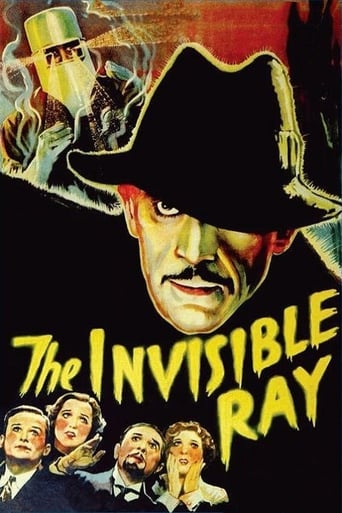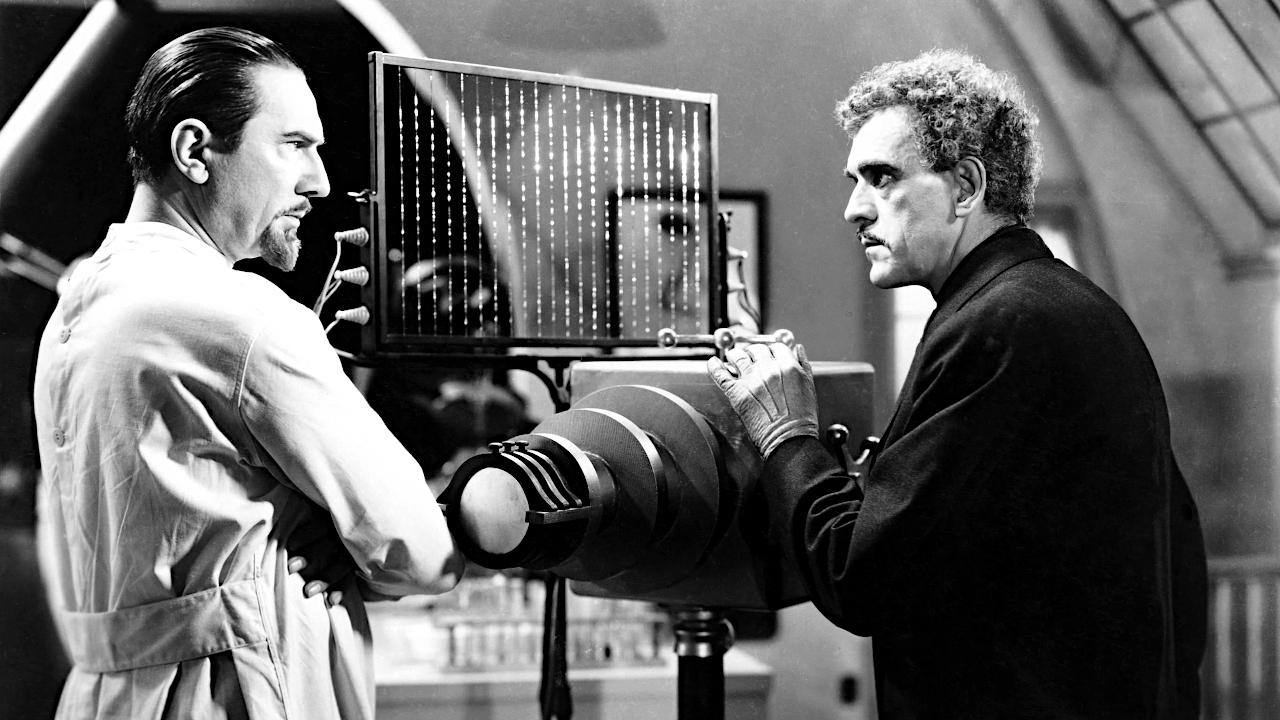poe-48833
The so-called "junk science" postulated in THE INVISIBLE RAY came as quite a shock to me: I've maintained since I was a teenager that it might actually be possible to look into the Past in exactly the same way. I'm no scientist (far from it), but the notion of Light traveling away from a star that no longer exists still being visible to us, here and now, makes the argument at least plausible. MY theory (such as it is) would require traveling to the point in Space at which the Earth was first "touched" by the aforementioned Starlight to observe Past Events. Sound shaky? Plausible? At any rate, THE INVISIBLE RAY was a most pleasant surprise. Highly recommended.
JoeB131
Universal tried to capitalize on the fame of Boris Karloff and Bela Lugosi by putting them in a bunch of vehicles together.In this one, Boris plays the Mad Scientist and Bela plays the good one, who find an element in Africa called "Radium X" because they couldn't think of cool new names for elements back then. Boris is infected with Raidum X, becoming a killing machine that glows in the dark if he doesn't take his meds. He proceeds to lose his wife to another man and then his mind, and goes on a killing spree.The ironic thing was, Lugosi always saw himself as a leading man, and this was probably as close as he got. His accent got in the way, and he didn't quite work here, being dead for the last five minutes of the movie.Cringe-worthy, the portrayal of African characters.
sddavis63
When you see Boris Karloff and Bela Lugosi as co-stars, you expect to find a well done horror movie, but this was actually quite different, representing as it did what I would describe as an early effort at science fiction. Karloff and Lugosi both play scientists (Rukh and Benet respectively) - competitors to an extent, until Rukh wins Benet over with a demonstration that proves his great theory. The science here was - to say the least - a bit rough around the edges (thus science fiction, with the emphasis on the fiction) but somehow Rukh harnesses some sort of ray from Andromeda that allows him to look at the earth "several thousand million years ago." In that pre historic time, a huge meteorite slammed into Africa, leaving deposits of a substance the scientists call "Radium X" - which can heal and destroy. A large portion of the movie is set rather tediously in Africa, on a search for the meteorite deposits, which Rukh eventually finds and harnesses to create a great weapon, unfortunately infecting himself with some sort of disease that makes him a great weapon as well.Karloff and Lugosi were both pretty good here. Lugosi pulls off a role in which he's the good guy pretty well, although I frankly found him a bit unconvincing - especially during the scenes set in Africa. The story also plodded along a bit, and while it held my attention it didn't captivate me. Given that this is really a sci-fi rather than a horror flick, and that sci-fi was in its very early stages, I suppose the movie needs to be cut a bit of slack. It was OK - nothing more, but also nothing less than that. 4/10
kennethfrankel
Some reviewers asked what the first rule of science is. I looked up that phrase with a search engine and found the following: "The first rule of science is that it deals with material causes and mechanisms. Scientists conduct their research in order to develop explanations for the world around us. They observe some natural phenomenon. They devise some explanation for this phenomenon, creating rules or models as they proceed. Then they carry out tests to see how well the explanation matches the real phenomenon.If the phenomenon continues to behave as their rules predict, their model, or "theory" is confirmed and scientists become more confident that it may be correct. If the phenomenon does something other than what their rules predict, the model has to be changed or scrapped altogether." This seems like the scientific method. It was interesting that the distance to the Andromeda Galaxy is now measured around 3 million light years, about 10 times the distance mentioned in the movie.They also show the Karloff character looking in the big telescope with the lights on in the room. This is what astronomers have to deal with today - they need complete darkness and must deal with a public that lives in a world of light. Most movies and TV shows also show the area around a telescope as well-lit. I guess nothing would show if it was dark.Your eyes are not cameras. Galaxies look like fuzzy blobs to the naked eye, but a long term exposure is needed to bring out the details as shown in the Andromeda image. Of course, a really big telescope shows more details. So again the general public is mislead by what is shown in movies. First time users think they will see Hubble telescope quality images.


 AD
AD






